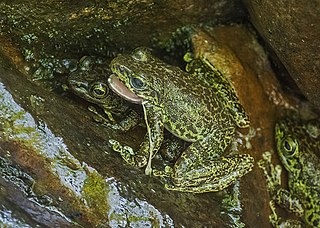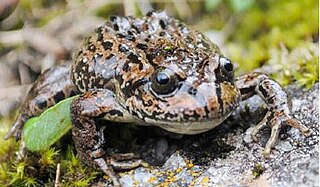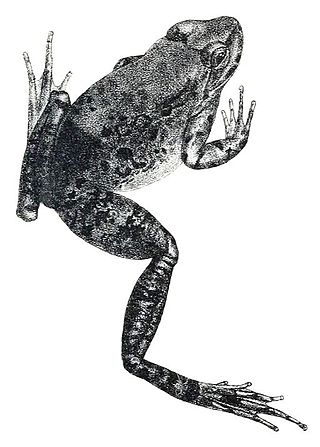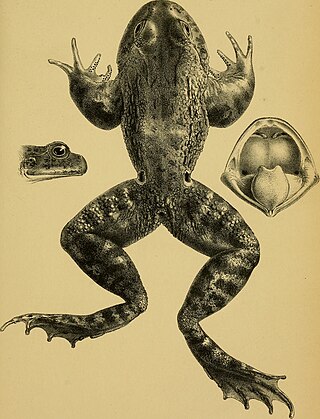Scutiger nyingchiensis is a species of toad found in the Himalayas of southeastern Tibet (China), northwestern Nepal, and tentatively, Bhutan. There are no confirmed records from India; earlier records refer to Scutiger occidentalis or Scutiger spinosus. Its type locality is Nyingchi, Tibet. It is also known as the Nyingchi high altitude toad, Nyingchi alpine toad, or Nyingchi lazy toad.

Scutiger sikimmensis is a species of toad in the family Megophryidae. It is found in northeastern India, Nepal, Bhutan, and Tibet. Many common names have been coined for this species: Sikkim lazy toad, Sikimmese pelobatid toad, Sikkim high altitude toad, Sikkim spade foot frog, Blyth's short-limbed frog, and Sikkim snow toad. It is very common in the high altitudes of Sikkimese Himalaya.

Amolops formosus, also known as Assam sucker frog, beautiful stream frog, Assam cascade frog, or hill stream frog, is a species of frog found in high gradient streams of northern India, northern Bangladesh, and Nepal, possibly also Bhutan, although these records may represent confusion between Amolops himalayanus and this species; the latest available IUCN assessment from 2004 treats A. himalayanus as a synonym of A. formosus.
Amolops monticola is a species of frog in the family Ranidae, the "true frogs". It is found in the Northeast India, eastern Nepal, and western China, although there is some uncertainty regarding the Chinese records. It probably also occurs in the intervening Bhutan. Common names mountain sucker frog, mountain stream frog, mountain torrent frog, and mountain cascade frog have been coined for it.
Nanorana quadranus is a species of frog in the family Dicroglossidae. It is endemic to central China. Its natural habitats are temperate forest and shrubland, with breeding taking place in small rivers. It is a common species believed to be declining. It is threatened by collection for food and also habitat loss.
Nanorana parkeri is a species of frogs in the family Dicroglossidae. It is found in Tibet (China) and in Nepal, but it is expected to be found also in Bhutan and parts of India. It is the second amphibian, and the first Neobatrachian, to have its whole genome published.

Nanorana pleskei is a species of frog in the family Dicroglossidae. Until recently it has been only known from southwestern/central western China from elevations between 3,300–4,500 m (10,800–14,800 ft), but there is now one record also from Bhutan. Notice, however, that earlier records outside China have turned out to be misidentifications.
Nanorana annandalii is a species of frog in the family Dicroglossidae. It is found in northeastern India and eastern Nepal. Nanorana gammii(Anderson, 1871) was until quite recently (2006) considered a synonym of Nanorana annandalii but is now treated as a separate species; this change confounds older records of Nanorana annandalii. This species lives in rocky streams and brooks in montane forests. It can also be found near pools in forest clearings. It is threatened by habitat loss (deforestation).
Nanorana arnoldi is a large species of frog in the family Dicroglossidae. It is found in southwestern China, northern Myanmar, eastern Nepal, and adjacent northeastern India. Its natural habitats are subtropical or tropical moist montane forest, rivers, and freshwater springs. It is primarily threatened by collection for consumption, but also by habitat loss.

Nanorana blanfordii is a species of frog in the family Dicroglossidae. It is found in northeastern India, southern Tibet (China), and eastern Nepal, and likely in the adjacent western Bhutan. The specific name blanfordii honours William Thomas Blandford, a British geologist and zoologist.
Quasipaa boulengeri is a species of frog in the family Dicroglossidae. It is known under many common names, including Boulenger's spiny frog, spiny-bellied frog, and Boulenger's paa frog. It is found in southern and southwestern China and northern Vietnam. It is a very common species that has declined. It is collected for human consumption, and it is also threatened by habitat loss. Its natural habitats are hill streams and ponds.

Nanorana conaensis is a species of frog in the family Dicroglossidae. Its name refers to its type locality, Mama in Cona County in Tibet. Note that while large parts of Cona County are located within Arunachal Pradesh in the area that is controlled by India but claimed by China, Mama is on the Tibetan side of the border. It has recently been reported also from Bhutan. Its natural habitats are subtropical moist montane forest, high-altitude shrubland, and rivers.
Nanorana ercepeae is a species of frog in the family Dicroglossidae. It is endemic to western Nepal. This relatively rare frog is found in stream habitats in upland temperate rainforests. It is threatened by habitat loss and degradation caused by small-scale agricultural development and wood extraction.

Nanorana feae is a species of frog in the family Dicroglossidae. It is found in Yunnan, China, and the Kachin Hills in Myanmar. The specific name feae honors Leonardo Fea, an Italian explorer, zoologist, and naturalist. This little-known species probably inhabits hill streams in forested areas.
Nanorana medogensis is a species of frog in the family Dicroglossidae. It is endemic to Tibet, China, and only known from near its type locality in Mêdog County in southeastern Tibet, near the Indian border. It lives in forested streams, and is sometimes also found at the edges of pools and ponds.
Nanorana polunini is a species of frog in the family Dicroglossidae. It is found in Nyalam County in southern Tibet (China), Nepal, and possibly Kashmir (India). It is a common species in Nepal but rare in China. It lives in stream habitats in montane forest.
Nanorana rarica is a frog species in the family Dicroglossidae. It is endemic to western Nepal. Its type locality is the eponymous Rara Lake located in the Rara National Park.
Nanorana yunnanensis, commonly known as Yunnan paa frog, Yunnan spiny frog, Bourret's paa frog or Bourret's frog, is a species of frog in the family Dicroglossidae. It is found in southwestern China, Vietnam, Myanmar, northern Thailand, and likely in the intervening Laos. Its natural habitats are small and large streams in montane forests, scrub vegetation and grasslands, and it has also been found in ditches. It is threatened primarily by collection for human consumption, but also by habitat loss caused by agricultural development and infrastructure development.

The Manaslu Conservation Area is a protected area in Nepal. Established in 1998, it covers 1,663 km2 (642 sq mi) in the Mansiri Himal range of the Himalayas in the Gorkha District. The area comprises mountains, glaciers, and watercourses. In elevation, the area ranges from 1,400 to 8,156










